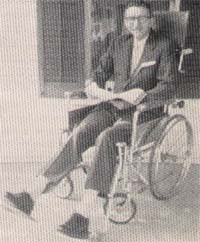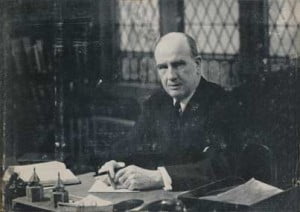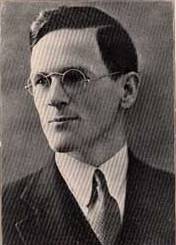It’s not always easy writing a biographical sketch for men who served in the old Bible Presbyterian Church or the Reformed Presbyterian Church, General Synod. These were the two groups which merged in 1965 to create the Reformed Presbyterian Church, Evangelical Synod, and neither group maintained anything like the ministerial directories that are available for both the OPC and the PCA. So details are often lacking in an account such as we have here today, taken from the memorial for Rev. Harry H. Meiners, Jr. This memorial was “spread upon the minutes” (i.e., it was included as part of the minutes) of the 1971 RPCES Synod.
I note right at the start of the following memorial, that nothing is said here of his parents, nor where he went to college, nor do we have his full birth date. Finding these added details will require going through volumes of old Presbytery records and other materials, but it is a project which I plan to start in earnest this summer, to construct a concise ministerial directory for the BPC (pre-1956) and the RPC,GS. Once we have that in hand, we will effectively have a directory for the RPCES. Some of this information is already available for those men who eventually became part of the PCA, but there are many others still to research. If you have biographical information for any of those men who might have died prior to the reception of the RPCES into the PCA in 1982, please contact me (see the About page).
 “Reverend Harry H. Meiners, Jr. was born in 1919. After college he took his seminary training at Westminster Theological Seminary, Chestnut Hill, Philadelphia.
“Reverend Harry H. Meiners, Jr. was born in 1919. After college he took his seminary training at Westminster Theological Seminary, Chestnut Hill, Philadelphia.
“Upon completion of his seminary training in 1950, he began to serve as the pastor of the Reformed Presbyterian Church of Duanesburg, New York, a member church of the Reformed Presbyterian Church in North America, General Synod. He served in this post until 1959, resigning due to the contraction of polio, which made it difficult for him to continue in active ministry.
“He moved to Las Cruces, New Mexico in July of 1959 for health reasons. Though his body was frail, it did not limit him in his desire to be of utmost service in the Lord’s work. He was largely responsible for the University Presbyterian Church of Las Cruces joining with the our denomination. That church has not only a fine membership from that community, but a strong student ministry to New Mexico State University located there. Since the church property adjoins that of the University, it has a most strategic location. Mr. Meiners has on several occasions served as interim pastor and moderator of the Church. He was held in highest esteem by the Church and not only ministered there but also at Westminster Reformed Presbyterian Church in Alamogordo.
“Mr. Meiners was one of the leaders largely responsible for the growth of the Reformed Presbyterian Church in North America and then in the union with the Evangelical Presbyterian Church. [Note: the EPC referred to here was originally named the Bible Presbyterian Church, Columbus Synod, taking the EPC designation from 1961 until its merger with the RPCNA, GS in 1965; it is not to be confused with that EPC which began its existence in 1981 and which continues today.] He served as the Stated Clerk of the RPC,ES from the time of the Union in 1965, having served in the same capacity in the Reformed Presbyterian Church since 1960. He was most proficient, conscientious and accurate. He manifested a great compassion for God’s people and a deep loyalty to Christ.
“At the 148th General Synod [1970], Mr. Meiners gave notice that he would be resigning at the time of the 149th General Synod due to a serious heart attack. Although it was not easy to give up this position which he loved, he was making every effort to turn over the responsibility and endeavoring to make it easier for his successor to take over the work. Just recently [early 1971] he suffered another serious heart attack and was again hospitalized, but seemed to be improving. Just the Sunday prior to his home-going, he attended both Morning and Evening Services of the Las Cruces Church. He spoke of his great yearning to continue to have an active part in our denomination through the ministry of prayer. On Sunday, May 9, early in the morning, he quietly slipped away to be with the Lord. He is survived by his wife, two daughters and three sons. His oldest daughter graduated from Covenant College last year and the next two children are now students of the College. [one son went on to serve as a missionary with the PCA’s Mission to the World agency.]
“A great leader and faithful servant has been taken from us. We will all deeply miss our brother who was so gracious and kind and brought so much encouragement to our movement. God’s ways are past finding out. Again, we are reminded that men come and go, but God and His work go on forever. May his home-going challenge all who knew him to be more faithful in service to the Lord, looking forward to the day of the appearing of our Lord. Mr. Meiners was faithful until death and to him has been given the Crown of Life. He has heard the word of His Master, “Well done, thou good and faithful servant…Enter thou into the joy of the Lord.” Matthew 25:21.”
Words to Live By:
Time and again we read that God uses the meek and lowly. Pay careful attention, for often the Lord uses times of adversity and hardship to bring about great works in His kingdom. Rev. Meiners was stricken with polio, and so surrendered his pulpit and moved to New Mexico . . . where he was vitally involved in the life of two more churches!




